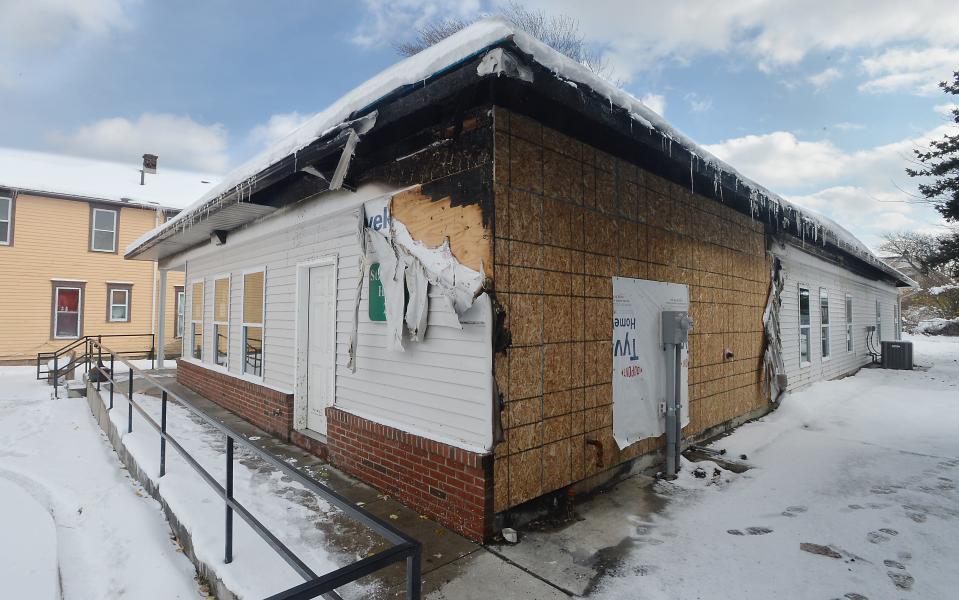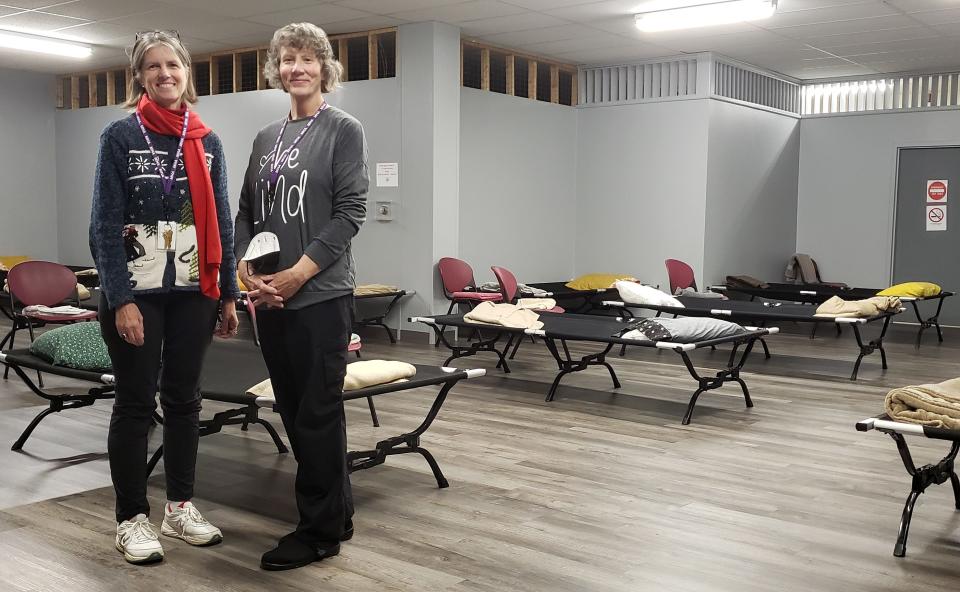'The greater good': Local agency steps up after fire leaves Erie shelter homeless
After St. Patrick’s Haven was ravaged by fire, smoke and water damage in mid-September, Betsy Wiest came to a realization about the nonprofit homeless shelter she oversees.
For the first time in its nearly 40-year history, and with winter quickly approaching, a place that specializes in assisting some of Erie’s most vulnerable citizens needed a major helping hand of its own.
No one was injured during the fire, reported shortly before 11 p.m. on Sept. 13 when the shelter was at capacity. But the blaze left the building uninhabitable and without a definitive reopening timetable.

“I just thought, ‘The homeless shelter is now homeless.’ We needed to figure something out quickly to help our guys,” said Wiest, executive director of St. Patrick’s Haven, 239 E. 12th St.
St. Patrick’s Haven, operated by the Sisters of St. Joseph of Northwestern Pennsylvania, opened in 1986 and moved into a new, $500,000 building in November 2017. The shelter provides overnight accommodations to as many as 24 homeless men each night on a first-come, first-serve basis.
2017 report:New St. Patrick's Haven shelter debuts
“I found it very ironic at that time that now we were the ones who needed help,” Wiest said. “Because we pretty much lost everything.”
That’s when the Mental Health Association of Northwestern Pennsylvania stepped in.

'Thankful and grateful'
On Sept. 30, a little more than two weeks after the fire, St. Patrick’s Haven opened a 20-bed, temporary overnight shelter located on the lower level of the Mental Health Association, 1101 Peach St.
“We are extremely thankful and incredibly grateful for this space,” Wiest said.
The Mental Health Association made the space available after Wiest, during a videoconference with local agencies that assist the region’s homeless, asked if anyone could help provide St. Patrick’s Haven with a short-term home.
The shelter at the Mental Health Association is open each day from 7 p.m. to 7 a.m. The temporary shelter provides hot coffee, snacks, the use of washers and dryers and access to showers. The space also allows St. Patrick’s Haven to continue serving the region's homeless men, many of whom are veterans.
St. Patrick's Haven houses about 7,000 overnight guests annually, according to the organization.
“We’re in it for the long run,” said Patricia Stucke, the Mental Health Association’s CEO. “If they're here for a year, whatever, so be it. We are happy to help.
“I knew we had the space. I went and talked to my senior staff, and they agreed with me that for the greater good, we need to help get these guys off the streets. It was really a pretty easy decision to make.”
Wiest said St. Patrick’s Haven is covering expenses for the temporary shelter and is also helping to pay “our share of utilities” at the Mental Health Association.
Planning better to help the homeless
Wiest said that the Mental Health Association’s decision to give St. Patrick’s Haven a temporary home is an example of the kind of proactive collaboration and frequent communication that exists among Erie-area social service agencies that deal with the region’s homeless population.
The pooling of resources and information sharing has been crucial in the wake of the COVID-19 pandemic, which restricted access to services, food and shelters for much of the homeless population.
Helping Erie's homeless:Multilayered plans underway as unsheltered population spikes
Pandemic impact:Erie’s homeless face new challenges due to coronavirus
The pandemic also created job losses in many cases that exacerbated homelessness.
According to Erie County's Single Point In Time count of the county's homeless population with other agencies, conducted in January, 789 people were identified in either permanent supportive housing or rapid rehousing programs; 224 people were living in emergency shelters; 53 were living in transitional housing; and 23 people were unsheltered, for a total of 1,089 individuals.
The count, coordinated each year by the Mercyhurst Civic Institute, is mandated annually by the federal Department of Housing and Urban Development.
During the pandemic, Mayor Joe Schember’s administration began getting input from various partners, including the Erie Community Foundation, Erie County government and various social service agencies, on how best to create a plan for how to most effectively allocate $2.9 million in American Rescue Plan funds earmarked for assisting the homeless and other vulnerable populations via housing, rental assistance and other services.
That planning, which continues, includes several organizations that are part of the Erie County Home Team, a coalition of local providers working to address homelessness in the region for more than 20 years. Both St. Patrick’s Haven and the Mental Health Association are Home Team members.
“The situation with St. Patrick’s Haven shows why we want these agencies to be communicating with each other constantly,” said Renee Lamis, Schember’s chief of staff.
Lamis said the city's homelessness funding plan is expected to be submitted to HUD by the end of the year.
"Homelessness is a complex issue," Lamis said. "The more we meet to work on solutions and develop relationships among service providers and between the Home Team, funders, and government agencies, the easier it is to resolve issues when they arise and to also proactively address the root causes of homelessness."
Wiest agreed.
“The mechanism that’s in place here made it easier for me to say, ‘Hey, we need help,’ and a lot of people heard that at one time,” Wiest said.
Stucke added that the pandemic, “has brought us all closer together. We realize someone who goes to the Haven overnight might need help from the Mental Health Association during the day. There’s a group of people out there that we all know and we’re all responsible for in some way, shape or form. We need to work together to help them.”
'Hard in the paint' for the homeless
Darnell Tillman, 52, has benefited from that collaboration.
Formerly homeless, Tillman is now a paid staff member at the Upper Room, a daytime homeless shelter located on the second floor of St. Paul’s United Church of Christ, 1024 Peach St.
Many of that shelter’s regular clients frequent St. Patrick’s Haven for overnight accommodations. Tillman was once one of them — he said stayed at St. Patrick's Haven, off and on, for about four years.
“I’ve been all over the country. Not many places go as hard in the paint as Erie does for the homeless,” said Tillman, using a basketball-inspired slang for giving maximum effort.
“If St. Patrick’s Haven was still closed, that would be a big problem for a lot of guys and they’d have nowhere to go,” Tillman said. “It’s hard work to get off the streets. The Upper Room and the Haven, those places are there to help you if you want it.”
Cris Taylor is the Upper Room’s executive director. The shelter is located less than a half-block northwest of the Mental Health Association.
“Every bed is important and critical in Erie," Taylor said.
“Now because of this, 20 people who might otherwise be downtown sleeping overnight next to a building, or in the woods or in Perry Square don’t have to,” Taylor said. “They get a stable environment.”
Grateful for a 'sense of community'
Careless smoking caused the St. Patrick’s Haven fire, which started outside the west side of the building in a trash can, according to Don Sauer, the Erie Bureau of Fire’s chief inspector.
The fire, which was ruled an accident, extended along the building’s west side to its attic, Sauer said. The fire was brought under control in about an hour. The 3,400-square-foot building suffered extensive smoke and water damage.
Wiest said St. Patrick’s Haven is working with its insurance company and contractors on plans to reopen its East 12th Street building.

She hopes construction will begin in early 2023, with the shelter reopening later that year.
St. Patrick’s Haven originally operated in a 3,200-square-foot building at 147 E. 12th St., a former residential home retrofitted to serve as a shelter. The shelter moved a block east in 2017, to its current space.
Featuring multiple guest rooms, a modern kitchen, a television lounge, a sitting room, multiple full bathrooms with showers and other amenities, the new St. Patrick’s Haven space was specifically designed as a shelter.
"There’s a real sense of community there," Wiest said. "We have a core of people who have been coming to us for a long time. Our guests frequently clean up the yard or mow the grass or pick up trash around the place. They took ownership of that building. It will be good to reopen."
Wiest said the fire underscores how vulnerable many of us are.
The temporary shelter's creation, she said, highlights the value of collective support.
“I talk about homelessness to groups around the community,” Wiest said. “I always tell people not to kid themselves because no matter who you are, you could become homeless tomorrow because of an economic downtown, a natural disaster, an act of violence or other reasons.
"So as a community, as a world, and as a society," Wiest said, "we always need to be ready to do what we can to walk with and help one another."
Contact Kevin Flowers at kflowers@timesnews.com. Follow him on Twitter at @ETNflowers.
This article originally appeared on Erie Times-News: The Haven men's shelter gutted by fire, 'thankful' for temp home

